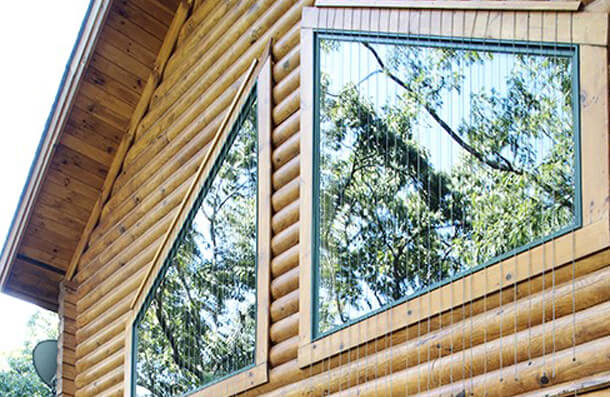This Fall, Help Migratory Birds Avoid Window Collisions
Contact: Jennifer Howard, 202-888-7472
(Washington, D.C., Sept. 28, 2016) Migratory birds are on the move, winging their way from nesting and breeding grounds in North America to winter habitat in Central and South America and the Caribbean. It's a spectacular journey—but it's one that many of them will never finish.
Habitat loss, outdoor cats, and pesticides all take their toll, but one of the biggest threats to the birds' safe travels is one they can't see. Hundreds of millions die every year in the U.S. when they collide with glass windows. High-rise offices create an obvious threat, but about half of collisions occur at private homes. Several birds of conservation concern are among the species most vulnerable to window collisions, including Golden-winged and Canada Warblers, Painted Bunting, and Wood Thrush.

"Zen window curtains" made with paracord are a neat way to make windows safer for birds. (Photo courtesy of Dr. Ellen K. Rudolph)
Help is as close as your local hardware or art-supply store. Window screens, painted designs, and bird tape or decals, properly applied, can all deter birds from flying into glass.
Watch a new video PSA from ABC that calls attention to bird collisions and showcases creative—and attractive—ways to help.
Creative solutions don't require spending a lot of money. “There's a solution for everybody and for every budget,” said Christine Sheppard, Manager of American Bird Conservancy's Bird Collisions Campaign. “Cost, aesthetics, ease of application, or how long it lasts—which solution you pick depends on what matters most to you."
General guidelines: Spacing is important! Most birds will avoid windows with vertical stripes spaced four inches apart or horizontal stripes spaced two inches apart. More complicated or irregular patterns will also work as long as they follow the same spacing rules. For best results, patterns must be on the outside surface of the windows.
Here are five ways to make your home windows bird-friendly and help our fall migrants reach their destinations safely. (Visit ABC's bird-smart glass page to see a list of more products, including materials designed for architects and builders. We'd love to see your solutions; send us a photo.)
- Paint designs on your windows. Apply tempera paint (available at most art and craft stores) freehand with a brush or sponge, or use a stencil. Tempera is nontoxic and long lasting, even in rain, but comes right off with a damp rag or sponge. Find stencils at craft stores or download free stencils online. Seasonal designs make for a fun family project. “This is a really good, quick, inexpensive solution,” Sheppard says.
- Install window screens. You can also stretch lightweight netting, screen, or other material over windows. The netting must be several inches in front of each window, so birds don't hit the glass after hitting the net. Several companies (birdsavers.com, for instance) sell screens, solar shades, or other barriers that can be attached with suction cups or eye hooks. (See also easyupshade.com, birdbgone.com, nixalite.com, or birdmaster.com.)
- Use patterned window film. Solyx Bird Safety Film, which can be ordered online, is intended to be applied to the outside of the glass and will last for years. “This is my favorite retrofit,” Sheppard says. “It's elegant and it works really well.” White CollidEscape is another excellent choice. (Note that most window films—solar films, for instance–designed for external use are not patterned and will not warn birds away from windows.)
- Create patterns with tape or stickers. (Remember the spacing guidelines above.) “Applied in the right patterns, tape really works, as long as it's not clear,” Sheppard says. Translucent or opaque tape can work as a temporary fix or longer term if it's made to last outdoors. Even a kid's sticker collection can be repurposed to keep birds away from windows. Note: You can use prefabricated decals—as long as you space them properly and use them on the outside of windows. The shape does not matter; birds see hawk-shaped decals as obstacles but not as predators. To be effective, decals must be spaced no more than every four inches horizontally and two inches apart vertically—more closely than recommended by most manufacturers.
- Buy or make your own “zen wind curtains.” (See photo.) Designed to be installed on the outside of the glass, Acopian BirdSavers zen curtains are made from paracord and can be custom-fitted to your windows. Handy or looking for a good weekend project? Try a DIY version.
###
American Bird Conservancy is the Western Hemisphere's bird conservation specialist—the only organization with a single and steadfast commitment to achieving conservation results for native birds and their habitats throughout the Americas. With a focus on efficiency and working in partnership, we take on the toughest problems facing birds today, innovating and building on sound science to halt extinctions, protect habitats, eliminate threats, and build capacity for bird conservation.


















































